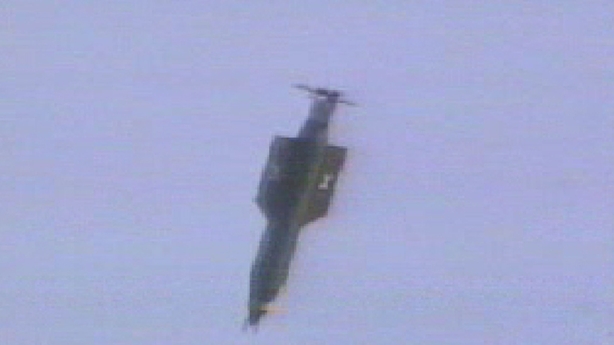The top US military commander in Afghanistan, General John Nicholson, has said that the decision to deploy one of the largest conventional bombs ever used in combat was purely tactical, and made as part of the campaign against the so-called Islamic State-linked fighters.
As many as 36 suspected IS militants were killed in the strike in the eastern province of Nangarhar, Afghan defence officials said, adding there were no civilian casualties.
The moment when the United States dropped its largest non-nuclear bomb over the Nangarhar province yesterday https://t.co/DnusflbXhD pic.twitter.com/sqBxK4NQru
— RTÉ News (@rtenews) April 14, 2017
Amaq, the news agency affiliated with IS in the Middle East, carried a statement denying that the group had suffered casualties in the attack, citing an unidentified source who had been in contact.
The statements could not be independently verified, and today Afghan and foreign troops in the vicinity were not allowing reporters or locals to approach the scene of the blast.
The strike came as US President Donald Trump prepares to dispatch his first high-level delegation to Kabul, amid uncertainty about his plans for the nearly 9,000 American troops stationed in Afghanistan.
Nicknamed "the mother of all bombs," the weapon was dropped from an MC-130 aircraft in the Achin district of Nangarhar, bordering Pakistan.

Mr Nicholson said he was in constant communication with officials in Washington, but the decision to use the 9,797kg GBU-43 bomb was based on his assessment of military needs and not broader political considerations.
"This was the first time that we encountered an extensive obstacle to our progress," he said of a joint Afghan-US operation that has been targeting IS since March.
"It was the right time to use it tactically against the right target on the battlefield," Mr Nicholson said.
Afghan and US forces were at the scene of the strike and reported that the "weapon achieved its intended purpose," Mr Nicholson said.
Afghan Defence Ministry spokesman Dawlat Waziri said no civilians were harmed in the massive blast that targeted a network of caves and tunnels that had been heavily mined.
"No civilian has been hurt and only the base, which Daesh used to launch attacks in other parts of the province, was destroyed," Mr Waziri said in a statement.
He was using an Arabic term that refers to Islamic State, which has established a small stronghold in eastern Afghanistan and launched deadly attacks on the capital, Kabul.
We need your consent to load this rte-player contentWe use rte-player to manage extra content that can set cookies on your device and collect data about your activity. Please review their details and accept them to load the content.Manage Preferences
The GBU-43 is a GPS-guided munition that had never before been used in combat since its first test in 2003, when it produced a mushroom cloud visible from 32km away.
In Achin village, about 5km from the remote, mountainous area where the bomb was dropped, witnesses said the ground shook, but homes and shops appeared unaffected.
"Last night's bomb was really huge, when it dropped, everywhere, it was shaking," said one resident, adding that he believed no civilians were in the area hit.
He praised the strike, saying killing IS fighters was a "positive move."
Other residents said they were used to seeing militants climbing up and down the mountain every day, making occasional visits to the village.
American officials said the bomb had been positioned for possible use in Afghanistan for "some time" since the administration of former president Barack Obama.
The US has steadily intensified its air campaign against IS and Taliban militants in Afghanistan, with the Air Force deploying nearly 500 weapons in the first three months of 2017, up from 300 in the corresponding 2016 period.
Yesterday's strike was not the first time Islamic State fighters have been targeted by heavy American bombardment in Nangarhar, where a US special forces soldier was killed battling militants a week ago.
US military officials estimate there are about 600 to 800 IS fighters in Afghanistan, mostly in Nangarhar, but also in the neighbouring province of Kunar.
The United Nations has raised concerns that the American air campaign is swelling civilian casualties in Afghanistan.
Last year, air strikes by international forces caused at least 127 civilian deaths and 108 injuries, up from 103 deaths and 67 injuries in 2015, the United Nations said.

